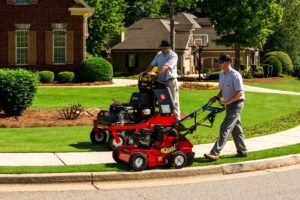With average summer temperatures rising and drought prevalent in many areas of the United States, it’s becoming much more common for homeowners to face dead, dry lawns. Few things look worse than a huge patch of brown grass and weeds, especially since it’s not always possible for your lawn to recover right away.
Fortunately, there are steps you can take to grow a full, lush lawn in the spring – even if it looks as though your grass has completely died.
Is the Grass Dormant or Dead?
The first thing you should do following a drought is determine whether the grass is fully dead (and therefore unrecoverable) or merely dormant. Most of the time, it’s the latter. Grass is very durable and will put itself in a period of dormancy whenever conditions aren’t ideal. Yes, it looks unhealthy, brown, and dry, but water and care will bring it back to life again.
There are two ways to determine the state of your lawn: you can get down to the roots to make an examination, or you can water a patch of the lawn to see how it reacts. A dormant lawn will still have green and off-white growth at the roots; a dead lawn will be brown and brittle all the way through. If you can see some life at the base of the blades, you can expect a full recovery. Grass that’s merely dormant will react to the water by growing green after a few days of diligent care.
If your lawn is dead, there’s nothing you can do to save it. Your only options are to remove the dead patches and either re-seed or sod it. If it’s dormant, the next steps will take you through the recovery process.
Drought Lawn Care
Although your instinct might be to water your lawn to bring it back to its former glory, it’s not always ideal (or possible) to water right now. It takes quite a bit of irrigation to get a lawn to recover, so if there are watering restrictions in your area, expected restrictions in the future, or other weather conditions to contend with, it might be best to let your lawn remain dormant for the time being. This way, you can prep the area and get it ready for spring, when you can water in abundance without fear of interruption. These are the general steps:
- De-thatch the Lawn: Dead organic matter will eventually break down on its own, but if you have too much of it, you’ll cover the roots of the grass and prohibit water and oxygen from getting where it needs to go. Use a de-thatching tool on your existing mower or invest in a rotary broom to clear away this dead matter.
- Aerate the Lawn: An aerator will help deliver moisture to the root system in the lawn, which is very important during the recovery stages. Most people plan to do this annually in the fall, so plan on either performing the task then or pushing it up a few weeks in late summer.
- Stop Foot Traffic: Yes, a dormant lawn can fully recover, but only if you treat it with more care than you normally would. It’s fine to walk over the lawn to de-thatch, aerate, and (later) re-seed, but avoid any non-lawn-care-related foot traffic, including kids and dogs.
- Overseed the Lawn: Since you’ll want to wait until conditions improve to fully restore the lawn, you should also plan on overseeding at this time. You’ll be providing lots of water, care, and fertilizer anyway, so you might as well take care of patchy areas that existed before, too. (This is a good time to choose a new grass type, as well. Some grasses, like St. Augustine or Bermuda, are very drought resistant. Others, like Fescue, don’t do well in the heat. Match your grass to your area to avoid dormancy in the future.)
- Water, Water, Water: As soon as you reach a time where you can water for several weeks without interruption, it’s time to bring the lawn back. Plan on watering deeply and fully at least twice a week, usually in the early morning, as this will allow the moisture to seep into the soil and get to work before the heat and sun of the day cause it to evaporate.
- Set Your Mower Height: You’ll still need to perform regular lawn maintenance, but it’s important to allow the grass time to recover. For this reason, sharpen the blades (to avoid damaging the grass as it’s cut) and set the height so that no more than 1/3 of the grass blade is removed at any time. You should also allow the mulch to remain on the lawn, as the added moisture will help foster healthy growth.
- Fertilize the Lawn: Although you might be tempted to fertilize right away, your grass needs water more than nutrients at this time. Plan on fertilizing once the growth takes hold and some of the green is recovered.
From there, you can most likely return to your regular lawn care schedule. It may take a few weeks before you start to see results, but careful watering and maintenance will ensure that your lawn comes back even better than before.
SHARE






